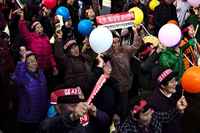South Korea: Second Jeju airport resistance intensifies – protest camp and hunger strike
Residents of five villages threatened with the loss of their homes for a second airport on Jeju island have set up a protest camp and their resistance is garnering support from many organizations.
Plans for a second airport in Jeju , an egg-shaped island off the south coast of South Korea, have met with vigorous and sustained resistance since the sudden announcement of the project two years ago, in November 2015. The proposed site is in Seongsan on the east coast of the island and residents of the five villages that would be affected, losing their homes and farmland – Susan-ri, Sinsan-ri, Nansan-ri, Goseong-ri and Onpyeong-ri – were not even consulted. Resistance has intensified in recent weeks and on 10th October a group of residents and representatives of civic groups opposing the new airport assembled a protest tent outside the Jeju island government hall and began a sit-in . The vice-chair of Seongsan people’s committee against the 2nd Jeju airport project, Kim Kyung-bae, began an indefinite hunger strike and fellow protesters began relay fasting to show their support.
The Jeju Provincial Government threatened to remove the protest tent, delivering a warning letter to the organizations protesting Jeju’s second airport, which stated that, if the protest tent was not removed by 17th October the government would forcefully dismantle it and claiming that the protesters are “illegally occupying the roads and causing traffic problems”. Protesters countered that their protest tent is located far enough from the road to avoid causing inconvenience to vehicles or pedestrians, as can be seen in the photo below.
Airport opponents only resorted to this sit-in protest because the Jeju Provincial Government refuses to communicate with them and the resistance camp remains, demonstrating protesters’ determination to maintain a visible presence, make their voice heard, and prevent imposition of the project. The photo below was taken on 21st October, marking the 12th day of the anti-airport sit-in and hunger strike. At the time of writing the protest continues on its 14th day, as does the succession of visitors finding out about the campaign and showing their support.
Airport plans are being pushed forward without involving the people who would be most seriously affected, the villagers facing the threat of eviction from their homes and loss of agricultural livelihoods. The protest camp builds on a series of small victories, recent actions which have successfully stalled the airport project, blocking a land survey and environmental impact assessment. More recently, on 18th September 2017, demonstrators brought a briefing session on the 2nd Jeju airport to a halt. The briefing session was organized without consulting residents of Seongsan where the airport would be built and held far away in the city of Seogwipo, a distance of about 60 kilometers. More than 70 people , residents from the affected villages and representatives of civic groups, staged a protest, challenging the procedural legitimacy of the briefing session, criticizing it as merely a tool for advertising the project and demanding a complete reassessment of the airport plans. The video below shows protesters gathering outside the meeting with a display of banners, then attempting to take the stage to make their voices heard, only to be blocked by a large number of officials.
Two years of resistance against a second Jeju airport
Over the two years since the second airport plan was announced there has been a series protests and rallies, with the participation of hundreds of people. Most of the site earmarked for the proposed airport, about 70 per cent, is a farming area so the project threatens agricultural livelihoods and food production. If the airport is built over 75 per cent of villagers of Seongsan would lose their homes and other villages would also be severely impacted. Anti-airport actions have drawn on shamanic traditions , channelling a multitude of spiritual energies such as the three founding fathers of the island and Youngdeung, the goddess of the wind and sea. Two years of resistance have seen houses sporting posters in their windows and streets bedecked with red and yellow flags and banners extending as far as 20 kilometers along the roads leading to affected villages.
Scores of villagers face being forced to leave their homes and farmland, sustaining their battle against the airport as they persevere with the cycles of rural life. In February 2017, as villagers were busy harvesting radish crops, Kang Wan-bo, chair of the Seongsanup Second Airport Opposition Committee, said that the government had failed to make any concessions regarding affected villagers’ objections and was attempting to force the airport plan through, even though Jeju’s 15 environmental NGO’s had joined forces to oppose it. When Governor of Jeju Province, Won Hee-ryong, made his first visit to the area for a year, villagers told him they felt as if they were being sacrificed for the tourism industry. Kang argued that continuing to expand the tourism on the island would be “ridiculous”, that citizens’ rights and protection of the environment should take priority over pursuit of an increase in tourist dollars.
A poll purported to show that a majority of respondents, 63.7 per cent, agree with the second airport plan. But the poll result was skewed because it only offered the two options of agreeing or disagreeing with building the second Jeju airport. Organizations protesting the new airport said that, in order to get a result that is more representative of people’s opinions, a range of options should be considered: building a second Jeju airport, expanding the capacity of the island’s existing main airport or reusing Jeongseok Airport, a facility near Hallasan National Park that is mainly used by private jets. Results of a poll conducted by organizations opposing the second airport showed just 24.4 per cent of respondents agreeing to the second airport. A higher proportion of respondents, 36.6 per cent, supported expansion of Jeju Airport and 20.8 per cent supported reusing Jeongseok Airport.
Plans for tourism megaprojects and an ‘Air City’
Airport planners and proponents envisage a second airport bringing an enormous influx of tourists to Jeju. But it would jeopardize the pristine natural environment that makes the island such an attractive tourism destination. Honinji Pond, a sacred historical area where farming on the island is thought to have originated, is near the proposed site. In addition the tranquility of a most unusual geological feature, UNESCO protected Seongsan Ilchulbong, also called ‘Sunrise Peak’, a visually striking volcanic cone 182 metres high with a green crater rising from the sea, would be ruined if aircraft flew nearby. A second airport would also support a suite of mass tourism megaprojects. Mainstream commercial tourist traps are in the pipeline, such as retail complexes, casinos and golf courses, along with theme parks and resorts commodifying Jeju’s distinctive ecological assets and unique heritage.
Plans for a second airport are also of megaproject proportions. Jeju Governor, Won Hee-ryong, stated that the new airport would be the largest project in the history of the island, costing US$3.5 billion and scheduled to be complete by 2025. Planners envisage a single runway facility with capacity for 25 million passengers per year, equivalent to current traffic levels at Jeju’s existing airport but the airport could be expanded with the addition of a second runway.
The airport would be the beginning of and focal point for an even larger development; an ‘Air City’ , another term for an aerotropolis, is planned around the airport, comprising shopping malls, convention facilities and financial centres. Anti-airport campaign leaders have voiced concerns that ecological destruction caused by the airport is set to be compounded by urban sprawl from the accompanying aerotropolis. Another tourism-oriented megaproject plan connected with the ‘Air City’ scheme, for a high speed network of rail and bus routes linking the island’s main established and upcoming tourism centres – with the second airport among the key nodes – has raised concerns regarding the environmental impacts of construction activities.
Solidarity with the Jeju peace movement
Anti-airport campaigners are also concerned that a second airport might be linked with militarization of the island. Many airport serve both civilian and military functions, and in March 2017 former Air Force Chief of Staff Jeong Gyeong-du, said the second airport should have a search and rescue facility (SAR), perceived by some commentators as code for an Air Force base. Military intentions were confirmed in when Air Force Director of Public Affairs, Lee Sang-gyu stated that a feasibility study into constructing an air base would commence in 2018. In 2012 a scheme for an air base near the southwestern tip of the island, using an airfield in Daejeong-eup, was abandoned after a public outcry and the proposal for an air base at the second airport met with equally fierce protest. The Ministry of Transport Plans hastily contradicted the statements made by senior military officials, denying plans for an Air Force base.
In spite of these denials and an apparent U-turn many people are still suspicious that a second Jeju airport would be used as an Air Force Base. These concerns have galvanized support for the airport opposition from peace campaigners active in the long-standing resistance campaign against Gangjeong Naval Base – Save Jeju Now . Gangjeong campaigners joined Seongsan residents at the briefing session protest on 18th September, and have made regular solidarity visits to support the current protest camp. Links have been forged between movements opposing overdevelopment and militarization and are becoming stronger.
Construction of the enormous naval base in the tiny fishing village of Gangjeong on the southern coast of the island, with capacity for 24 warships, met with a sustained non-violent struggle. A decade of campaigning and direct action, blocking bulldozers and delivery of equipment, at the site entrance and taking to the sea in kayaks, repeatedly stalled construction. Gangjeong Naval Base was approved against the will of the 94 per cent of the village population who voted against it in a referendum. Jeju has a deep rooted culture of peace activism, it is known as the ‘island of peace’, and the naval base goes against this by militarizing the area and strengthening the country’s alliance with US defence interests. Construction of the naval base also caused environmental damage. Unique and delicate marine ecosystems were destroyed with serious impacts on marine food sources such as abalone (sea snails) and fishing livelihoods.
Since the naval base became operational , with the first US Navy vessel docking at the facility in March 2017, resistance continues with peace campaigners maintaining a lively presence outside the entrance gates. Gangjeong Naval Base is also linked with expansion of mass tourism; as a joint military and civilian port it is anticipated to begin docking giant 150,000 tonne cruise ships in the near future. The second Jeju airport project is over ten times larger than the naval base and the budget four times higher. But hopefully the scale of the project can be outdone by the strength of the opposition it has triggered. Hopefully the determination of the Seongsan residents who do not want to leave the homes, combined with the convergence of many individuals and organizations expressing support for their struggle, will lead to the cancellation of the airport project.
The campaign against the 2nd Jeju airport has a Facebook page .
On GAAM’s YouTube channel we are compiling a playlist – ‘Resisting 2nd Jeju airport’ , with videos of the many protests and rallies.

